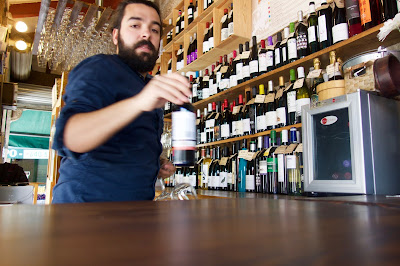 |
| Ferdinand and Isabela |
If you get to Santiago de
Compostela, do yourself a favor, if not your budget, and have a scrumptious
lunch at the Parador. Not a familiar
name? Paradors are a series of historic
building in Spain that the government has turned into luxurious hotels, the
interiors decorated with antiquities, and featuring fine dining, as well as
exquisite guest rooms.
The one in Santiago, Parador
de los Reyes Católicos, was founded by Ferdinand and Isabela (1486) as a hostel
and hospital for pilgrims staggering in from The Way of Saint James. The construction took ten years. Sits right
across from the famous cathedral. No
longer just for pilgrims, it’s a first class establishment, although I’ve been
told pilgrims get a discount. The hotel
is often noted as the most beautiful in Europe.
I hesitate to dispute that claim, although I haven’t done a personal
survey of all the hotels in Europe.
Don’t feel like throwing down
a wad of cash for a room, or even burning some plastic on a memorable
meal? Stop in for a drink at the inside
bar or the outside café. Reasonable,
especially for a window on the beating heart of this fab city
Follow this link to find out
more about the Parador system and to make reservations: http://www.parador.es/fr/paradores/parador-de-santiago-de-compostela?gclid=Cj0KCQjw78vLBRCZARIsACr4cxwk6kerhDB9wGIlzI59ILNO_gCFluTBy3h3pXF9pMDSjm8FsZcuOo8aAsfaEALw_wcB&gclsrc=aw.ds
Recently, I had the honor of
joining friends for cocktails and lunch at the Parador de Santiago. The experience is as if you’ve joined the
fashionable upper crust, if only for a couple of hours. After all, what joy is there without a vivid imagination and soul soothing alcohol?
The outdoor café overlooks
Santiago’s main square, Plaza
Obradoiro, and the inside bar has the feel of an English men’s club,
featuring deep padded leather arm chairs, a long bar of dark wood and a wait
staff so attentive you’ll feel as if you hired them
yourself. This ain’t Mickey D’s friends,
this is the look and feel of stately, old style luxury. Take a moment to stroll out into the central stone
courtyard, festooned with ancient pillars and arches. Check out the mother-in-law…I mean gargoyle
in the upper corner.
My traveling companion and I
had already had drinks in the outdoor café several times. I recommend the Bloody Marys. Also, the wines of any variety. Also the Sherry….also the …well, I think
you’re beginning to glimpse my motivation.
The café’s a noble respite from daily cares and mundane commerce. But this day, since my friend’s wife had just
completed The Way of Saint James, we opt for indoor drinks and a leisurely spot
of lunch in the cavernous great hall.
Parador cuisine is first rate
and features an ever-changing menu of area specialties. We opt for Chochinillo Asado (roast suckling pig), Lubina (sea bass) and beef tenderloin. (By the way, for those of
you still struggling with eighth grade English, op is the singular, opt
is the past tense. Just trying to
help. Opted sounds like you have a lisp or are missing a front tooth.)
The Parador has been many
things at many times, and as I mentioned it served as a hospital for
pilgrims. But, that was centuries ago,
when the best you could hope for from the hospital staff was educated murmurs over
blisters and a little blood letting on your way to the great beyond. What is now the great dining hall, with
splendid curved arches, was the hospital morgue. Probably shouldn’t bring that up at lunch, or
you may bring up lunch along with it.
Don’t you just love it when
the waiter (didn’t see any female wait staff) removes the bones from your
grilled fish?
I’ve run out of superlatives,
but take it from a stingy man, our visit, drinks and lunch at the Parador de
Compostela may have emptied my wallet, but it filled my belly and stroked my
self-esteem.
Put this Parador and every
other Parador on your list.
Other blog entries on Santiago
de Compostela:









































